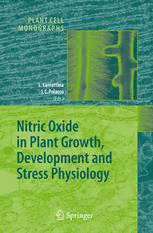
Nitric Oxide in Plant Growth, Development and Stress Physiology PDF
Preview Nitric Oxide in Plant Growth, Development and Stress Physiology
6 Plant Cell Monographs SeriesEditor:DavidG.Robinson PlantCellMonographs RecentlyPublishedTitles NitricOxideinPlantGrowth, DevelopmentandStressPhysiology VolumeEditors:Lamattina,L.,Polacco,J. Vol.6,2007 TheExpandingCell VolumeEditors:Verbelen,J.-P.,Vissenberg,K. Vol.5,2007 ThePlantEndoplasmicReticulum VolumeEditor:Robinson,D.G. Vol.4,2006 ThePollenTube ACellularandMolecularPerspective VolumeEditor:Malhó,R. Vol.3,2006 SomaticEmbryogenesis VolumeEditors:Mujib,A.,ˇSamaj,J. Vol.2,2006 PlantEndocytosis VolumeEditors: ˇSamaj,J.,Baluˇska,F.,Menzel,D. Vol.1,2005 Nitric Oxide in Plant Growth, Development and Stress Physiology Volume Editors: Lorenzo Lamattina,Joseph C. Polacco With39Figuresand5Tables 123 VolumeEditors: ProfessorDr.LorenzoLamattina ProfessorJosephC.Polacco InstitutodeInvestigacionesBiol´ogicas DepartmentofBiochemistry FacultaddeCienciasExactasyNaturales 112SchweitzerHall UniversidadNacionaldeMardelPlata UniversityofMissouri-Columbia CC1245,(7600)MardelPlata Columbia,MO65211 Argentina USA SeriesEditor: ProfessorDr.DavidG.Robinson Ruprecht-Karls-UniversityofHeidelberg HeidelbergerInstituteforPlantSciences(HIP) DepartmentCellBiology ImNeuenheimerFeld230 D-69120Heidelberg Germany LibraryofCongressControlNumber:2006932400 ISSN1861-1370 ISBN-103-540-45128-5SpringerBerlinHeidelbergNewYork ISBN-13978-3-540-45128-0SpringerBerlinHeidelbergNewYork DOI10.1007/11563280 Thisworkissubjecttocopyright.Allrightsarereserved,whetherthewholeorpartofthematerial isconcerned,specificallytherightsoftranslation,reprinting,reuseofillustrations,recitation,broad- casting,reproductiononmicrofilmorinanyotherway,andstorageindatabanks.Duplicationof thispublicationorpartsthereofispermittedonlyundertheprovisionsoftheGermanCopyrightLaw ofSeptember9,1965,initscurrentversion,andpermissionforusemustalwaysbeobtainedfrom Springer.ViolationsareliableforprosecutionundertheGermanCopyrightLaw. SpringerisapartofSpringerScience+BusinessMedia springer.com (cid:1)c Springer-VerlagBerlinHeidelberg2007 Theuseofregisterednames,trademarks,etc.inthispublicationdoesnotimply,evenintheabsence ofaspecificstatement,thatsuchnamesareexemptfromtherelevantprotectivelawsandregulations andthereforefreeforgeneraluse. Editor:Dr.ChristinaEckey,Heidelberg DeskEditor:AnetteLindqvist,Heidelberg Coverdesign:WMXDesignGmbH,Heidelberg TypesettingandProduction:LE-TEXJelonek,Schmidt&VöcklerGbR,Leipzig Printedonacid-freepaper 149/3100YL–543210 Editors LorenzoLamattina was born in Argentina, wherehestudied agronomyand biologyandobtainedhisPh.D.fromtheUniversityofMardelPlata.Hedid postdoctoralresearchattheInstitutdeBiologieMoleculairedesPlantes(IBMP- CNRS) atStrasbourg,France, where he and his co-workers discovered RNA editinginplantmitochondria.In1991,hejoinedtheInstitutodeInvestigaciones Biologicas(IIB),attheFacultyofExactandNaturalSciences,UniversityofMar delPlata,asprofessorofmolecularbiology.HechairedtheIIBfrom2000to2004 andsince1999hasbeendirectoroftheMolecularandIntegrativePhysiologyLab. Hehastaughtmolecularbiologyandplantmolecularbiologytoundergraduate andgraduatestudents.Hisresearchfocusesonpathwaysandmoleculesinvolved innitricoxide(NO)-mediatedprocessesinplants.Initiallyfocusedonthean- tioxidantpropertiesofNOanditsprotectionagainstthedeleteriouseffectsof reactiveoxygenspecies(ROS),hisresearchhasrecentlydealtwiththeNOregu- lationofstomatalclosure,adventitiousandlateralrootformationaswellasroot hairdevelopment.Morerecently,thestudiesrelatedtotheNOinvolvementin plantironmetabolismandtransportisfindingapplicationinseveralareas. LorenzoLamattinaisamemberofseverallearnedsocieties.HeisaGuggenheim Fellow(2005–2006)andheobtainedthe2006awardfromtheBungeandBorn FoundationforhisresearchregardingNOeffectsinplantbiology. JoePolacco, anativeofBrooklynNY,obtainedhisB.S.atCornellUniversity andPh.D.atDukeUniversity,bothinbiochemistrywithemphasesinchem- istryandgenetics,respectively.Aftertwoyearsasanassistantprofessoratthe UniversidaddelValleinCali,Colombia,heheldasix-monthpostdoctoralpo- sitionatBrookhavenNationalLaboratories,whereheenteredthefieldofplant scienceunderthetutelageofPeterCarlson.Subsequently hespentfiveyears asastaffgeneticistattheConnecticutAgriculturalExperimentStation–the oldestintheU.S.andinternationallysecondonlytothatatWageningen.Since 1979hehasbeenamemberoftheBiochemistryDepartmentoftheUniversityof Missouri-Columbia.Hehastaughtundergraduatesandintheschoolofmedicine andgraduateschool.Heintroducedbiotechoutreachcoursesfornon-science majors,suchas“BiotechnologyinSociety.”Hisresearchhastouchedonmi- tochondrialfunction,lipoxygenaseroles,Nimetabolismandplantinteractions withmethylotrophiccommensalbacteria.Themainfocusofhisresearchisthe assimilationoffixednitrogenintheformofureidesandonmobilizationofN reserves.Hisinterestinnitrogenmetabolismleddirectlytostudiesonnitric oxide(NO)productionandfunctioninplants. JoePolacco,twiceaFulbrightFellow,hasextensiveinternationalexperiencein science.HiscollaborationwithLorenzoLamattinainvolvedafive-monthstay inhislab,followedbyhostingDr.LamattinaasaGuggenheim Fellow.Heis amemberofseveralscientificsocietiesandanaward-winningteacher. Preface Nitric oxide (NO) has definitively emerged as a ubiquitous molecule in life anditsstudyhascontributedtoabetterknowledgeofmanymechanismsand functions that were not well understood until very recently. NO is probably the inorganic molecule with the best characterized influence on biological processes. It has been proposed that at earlier stages of evolution, NO could have acted as an antioxidant. As complexity evolved, new and specialized antioxidant activities coevolved to detoxify reactive oxygen species (ROS). Thus, NOwasacquiring newfunctionstocontributetothecurrentexquisite network of cellular signaling. We now know that NO is involved in disease resistance,abioticstress,growthanddevelopmentprocesses,celldivisionand celldeath,nervoussystemresponses,immuneresponses,etc. ThereareseveralsourcesofNO.However,itschemicalnatureandstructure makeNOevenmorefascinating.NOisagas,afreeradicalwithanunpaired electron,butwithoutcharge.ThesepropertiesenableNOtomovewithincells, crossmembranesandberemovedefficientlybydifferentcellularcomponents. Becauseofitsrapidmovement andremoval,thebehaviorofNOinsignaling is optimal (Neil et al. 2003; Lamattina et al. 2003). NO is able to switch on and switch off, in a precise manner, a number of cellular functions. NO can also interact with other signaling molecules contributing to the generation of amplified signaling cascades. NO behaves like a hormone. Its versatility confers to this molecule the property of acting simultaneously in different cellular compartments and in opposite directions. This ability is essential to accomplishahousekeepingroleinhomeostaticcellprocessesandtoact,atthe sametime,asasynchronizerofcellularmetabolism. TheNOsourceinplantsconstitutesacomplexpanorama.NOcanbegener- atedthroughenzymaticandnon-enzymaticpathways,eachofwhichisfinely tunedandregulated(Yamasakietal.1999,Guoetal.2003,Corpasetal.2004, Rockeletal.2002,Bethkeetal.2004).Thiscomplexitychallengesgeneticap- proachestounravelplantNOfunctionality.InadditiontotheabilityofNOto crosscellmembranesandhenceactat“adistance”,theintracellularlocaliza- tionofthedifferentNOsourcesmightbelinkedtodifferenttargetsandtothe regulationofdifferentphysiologicalprocesses. NoDNAsequence hasbeenfoundtobindNOdirectly.However,microar- rays,northernblotsandAFLPanalyseshaverevealedthatNOisimplicatedin VIII Preface theregulationofthelevelofnumeroustranscriptsinArabidopsis.Theresults indicatethatNO-regulatedgenesareinvolvedineveryaspectofplantgrowth anddevelopment,aswellasinstressresponses(Polverarietal.2003,Paraniet al.2004,Heetal.2005).Inaddition,post-translationalmodificationsinduced byNOthroughS-nitrosylationhaverevealedanimpressivenumberofproteins aspotential NOtargets(Lindermayr et al. 2005). These proteins are thought to be involved in primary and secondary cell metabolism. Furthermore, the abilityofNOtobeoneofthecellularmessengersinvolvedintheregulationof cytosolicCa2+concentrationwhile,nitricoxidesynthase(NOS)isitselfaCa2+- dependent activity, make NO an excellent candidate as a signaling molecule ineveryCa2+-modulatedcellresponse(Garcia-Mataetal.2003;Lamotteetal. 2004;Lanterietal.2006). FigureAshowstheexponential growthinthenumber ofpapersthathave appeared in a 10 years period (1995-2004) concerning NO action in plant biology. In comparison to the number of papers on auxin over the same period, it can be observed that NOis rapidly catching up thisin an exciting eraofworldwideauxinresearch.FigureBshowsthattheratiobetweenauxin- Preface IX vsNO-relatedpublicationswas19infavorofauxinin1995,whereastheratio droppedto1.4in2004. Finally,theindustrialrevolutionanditssubsequentexponentialgrowthled tobothenvironmentalpollutionandaparallelincreaseofNOlevels.Increased NOlevelsinthetropospherebringaboutanaturalpressureonNO-regulated processesinbiosphere.Wehavenoidea,atthemoment,abouttherealsignifi- canceofthatpressureanditsevolutionaryside-effects.However,wewouldlike tociteatleasttwoexamplesthattouchonthisquestion:(i)pharmacologistsat theFreeUniversityofBerlinobtainedunexpected resultsinameasurements oftheNO-regulatedguanylatecyclase(Friebeetal.1996)and(ii)treesinNew York’sCentralParkshowedbettergrowththanthoseofneighboringruralar- eas as aresult of NOx-mediated depletion ofurban growth-inhibiting ozone (Gregg et al. 2003). Thus, at least these particular examples possibly corrob- orate the popular saying “What doesn’t kill you, makes you stronger”. They alsopointtotheneedforinteractivemolecularandecologicalapproachesto understandtheadaptivechangesoccurringinaverydynamicequilibrium. The revolution of genomics, proteomics and metabolomics has infused afloodofdatainbiology.Nevertheless, basic ecological,biochemical,physi- ologicalandcellularbiologicalapproachesarebeingrevisitedtovalidateand integrate the voluminous bioinformatics and in silico data. This book com- pileschapterseachofwhichprovidesabalancedtreatmentofnewresultsand prospectsineveryfieldofNObiologyinplants,fromphysiological,biochemi- calandmolecularpointsofview.Weintendthisbooktobeprovocative,butat thesametime,avaluablesourceofinformationandatooltoinspirescientists tothinkabouthowNOcouldbeavariableintheirownfieldsofplantresearch. ConsideringthatthemajorityofthedatareportingNOactioninplantbiology has appeared during the last 8 years, this book will be absolutely necessary for teachers and students to update “standard” knowledge in plant biology courses.Allthechaptersofthisvolumewerewrittenbyactivelyworkingplant scientists. Theeditorswouldlike toexpress their gratitudefortheir valuable contributionsandwehopethattheyspurfurtheradvancesbyyouthereader. We are certainly embarking on a century that will bring us unexpected and excitingdiscoveriesinvolvingNOactionsinplants. MardelPlata,Argentina LorenzoLamattina Columbia,MO,USA JosephC.Polacco Finally, wewishtoremember withaffectionourdearcolleagueDr.Radomir Konjevi´c(correspondingauthor,chapter6)whodiedonJuly22nd,2006. X Preface NoteaddedinProof Durnerandcoworkers(Zemotjeletal.,2006)havecalledtoquestiontheactual activityoftheproteinencodedbyAtNOS1.Theyhavenotbeenabletodetect NOS activity in the recombinant protein using both an [3H]-arginine and aGriessreagent-basedNOSassay.Crawfordandcolleagues,intheirresponseto Durner’sletter(Crawfordetal.,2006),haveacceptedthatthenewexperiments show no detectable citrulline in the analysis of the products produced from [14C]-arginineinpresenceoftherecombinantAtNOS1.Moreover,theattempts toreproducethereportedproductionofNOusingtheGriessreagenthavealso failed. That Atnos1 produces much less basal NO than wild type is indisputable (Guo et al., 2003), hence the proposed renaming of the gene as NOA1 (NO- Associated 1). However, since the molecular basis of the Atnoa1 phenotype isunknown,itsuseasagenetictoolinmanipulatingendogenousNOisnow strongly diminished. Science is a self-correcting mode of inquiry, and erro- neousresultsmustbeaccepted, rapidlycommunicated tothescientific com- munity, and then withdrawn.This new turnofevents willundoubtedly help deterusfrommakingwrongturnsinthecontinuingquestforNOsourcesin plants. References BethkePC,BadgerMR,JonesRL(2004)Apoplasticsynthesisofnitricoxidebyplanttissues. PlantCell16:332–341 Crawford NM, Galli M, Tischner R, Heimer YM, Okamoto M, Mack A (2006) Response toZemojteletal.:Plantnitricoxidesynthase:backtosquareone.TrendsinplantSci (Novemberissue) CorpasFJ,BarrosoJB,delR´ıoLA(2004c)Enzymaticsourcesofnitricoxideinplantcells– beyondoneprotein-onefunction.NewPhytologist162:246–248 FriebeA,MalkewitzJ, SchultzG,KoeslingD(1996) Positiveeffects ofpollution?Nature 382:120 Garcia-MataC, Gay R, SokolovskiS, HillsA, LamattinaL, BlattMR (2003) Nitricoxide regulatesK+ andCl–channelsinguardcellsthroughasubsetofabscisicacid-evoked signalingpathways.ProcNatlAcadSciUSA100:11116–11121 GreggJW,JonesCG,DawsonTE(2003)Urbanizationeffectsontreegrowthinthevicinity ofNewYorkCity.Nature424:183–187 GuoFQ,OkamotoM,CrawfordNM(2003)Identificationofaplantnitricoxidesynthase geneinvolvedinhormonalsignaling.Science302:100–103 He J-M, Xu H, She X-P, Song X-G, ZhaoW-M (2005) Theroleand theinterrelationship ofhydrogenperoxideandnitricoxideintheUV-B-inducedstomatalclosureinbroad bean.FunctionPlantBiol32:237–247 LamattinaL,Garcia-MataC,GrazianoM,PagnussatG(2003)Nitricoxide:Theversatility ofanextensivesignalmolecule.AnnRevPlantBiol54:109–136 LamotteO,GouldK,LecourieuxD,Sequeira-LegrandA,Lebrun-GarciaA,DurnerJ,Pu- ginA,WendehenneD(2004)Analysisofnitricoxidesignalingfunctionsintobaccocells challengedbytheelicitorcryptogein.PlantPhysiol135:516–529 Preface XI Lanteri ML, PagnussatGC, LamattinaL(2006) Calciumand calcium-dependent protein kinasesareinvolvedinnitricoxide-andauxin-inducedadventitiousrootformationin cucumber.JExpBot57:1341–1351 LindermayrC,SaalbachG,DurnerJ(2005)ProteomicidentificationofS-nitrosylatedpro- teinsinArabidopsis.PlantPhysiol137:921–930 NeillSJ,DesikanR,HancockJT(2003)Nitricoxidesignalinginplants.NewPhytol159:11–35 ParaniM,RudrabhatlaS,MyersR,WeirichH,SmithB,LeamanDW,GoldmanSL(2004)Mi- croarrayanalysisofnitricoxideresponsivetranscriptsinArabidopsis.PlantBiotechnolJ 2:359–366 PolverariA,MolesiniB,PezzottiM,BuonaurioR,MarteM,DelledonneM(2003) Nitric oxide-mediated transcriptional changes in Arabidopsis thaliana. Mol Plant Microbe Interact16:1094–1105 Rockel P, Strube F, Rockel A, Wildt J, Kaiser W (2002) Regulation of nitric oxide (NO) productionbyplantnitratereductaseinvivoandinvitro.JExpBot53:103–110 YamasakiH,SakihamaY,TakahashiS(1999)Alternativepathwayfornitricoxideproduction inplants:newfeaturesofanoldenzyme.TrendsPlantSci4:12 Zemojtel T, Frohlich A, Palmieri MC, Kolanczyk M, Mikula I, Wyrwicz LS, Wanker EE, MundlosS,VingronM,MartasekP,DurnerJ(2006)Plantnitricoxidesynthase:anever- endingstory?TrendsinPlantSci(Novemberissue)
